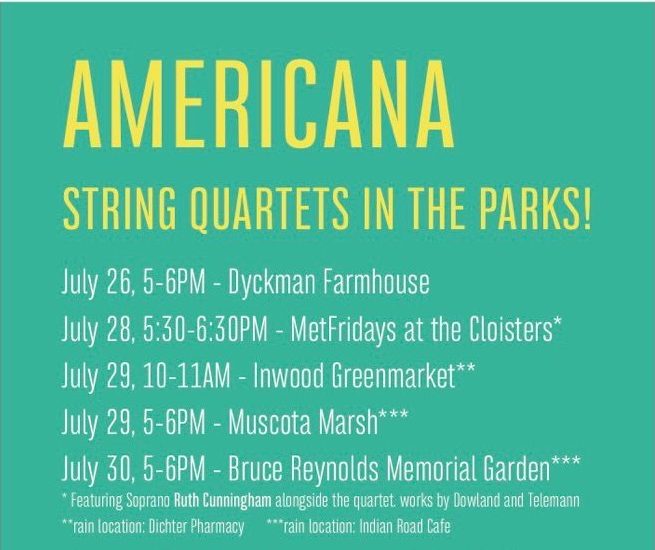Last month I had the pleasure of premiering my second string quartet with Listen Closely Inwood. I wrote a little bit more on the work which you can read below, and was originally posted on Listen Closely’s blog.
On String Quartet No. 2
When Listen Closely NYC asked me to write a new string quartet based on Inwood’s history, I eventually settled in on writing about three of the parks that surround the neighborhood of Inwood. Beyond any specific reference to aspects of the Isham, Inwood Hill and Fort Tryon parks, I also wanted to delve into the multiple levels of what a park does for an urban area like New York City. I wanted to also explore the admittedly common aspects of inspiration which nature and landscape frequently serve—on a personal level—to a composer.
When reviewing a history of the parks and comparing them to the perspective of present day city government manifestos on the function of ‘the park’, it is easy to see that parks are set up in opposition, or relief, to the contemporary urban landscape. In 2014, New York City Mayor Bill DeBlasio and the New York City Parks Commissioner Mitchell Silver laid out the language clearly in NYC Parks: Framework for an Equitable Future, where parks are described as “green oases” in contrast to the urban surroundings, and that park spaces have, “a sustained, positive effect on an individual’s health.” (http://www.nycgovparks.org/downloads/nyc-parks-framework.pdf) This language was also espoused approximately 150 years earlier by Frederick Law Olmsted—the architect of Central Park. (http://www.fredericklawolmsted.com/philos.html)
What is missing largely from the rhetoric of political and philosophical arguments for parks is a recognition of the interplay between the green-spaces and the city that surrounds them. While these nature refuges are much needed by citizens to escape the rush of urban zones, they are also simultaneously encroached upon by the surrounding densities of concrete and steel. Parks are carved by boulevards and pathways for access (access is not a bad thing—to be clear), or are limited in space and internally pockmarked with landmarks or constructions, all of which keep a total urban escape or “refuge” from being realized.
This complexity—that of being within a city, while also having refuge from it simultaneously—is a psychological musical idea that I wanted to explore. In developing the harmonic language for this work, I wanted to utilize an intervallic language that simultaneously afforded a duality of emotional tension and relief. This was realized through a pitch class set whose prime form is [0157]. The inversion of this set is [0267], which has a much softer characteristic to my ear. Due to the aesthetic and physical qualitative differences within the two forms of the set, I found the set’s duality suitable to demonstrate the aforementioned simultaneity of being ‘within’ and ‘without’ that occurs when in a park’s ground. The first movement of this work traverses through different motivic and emotional ideas as the formal key areas cycle towards the resolution of a complete chromatic field.
The second movement’s formal structure unfolds in a similar way (cycling through a chromatic field), this time using a different set which is based on a combination of the first movement’s organizing pitch classes. The music in this movement acts a bit differently than the first in that it does not seek to explore deeper psychological entwinements. Instead the work is referential to aspects of Inwood Hill Park’s creation (glacial scraping and grinding) and its current day inhabitants (a species of bird which call the park its home)—here the story is the past and the present.
The final movement involves a personal narrative around a place in Fort Tryon Park. I will leave what is heard up to the audience.
-Eric Lemmon, July 2017
https://www.listenclose.ly/connect-with-us/2017/7/17/eric-lemmon-on-his-string-quartet-no-2
